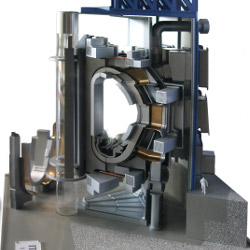Our species’ insatiable hunger for energy is in a permanent conflict with our quest to keep our planet clean. Some nation-states’ “clean energy” marketing is almost hypocritical given how little they do to address the root cause of rampant energy consumption: hyper-consumerism^.
Anyway… how can we get cleaner energy?
Fusion via tokamak
Fusion^ is the holy grail of energy generation. It’s clean and the necessary fuel, hydrogen, is literally everywhere. Unfortunately, replicating the Sun’s mastery of fusion isn’t exactly a piece of cake.
Once heralded as the world’s first nuclear fusion experimental reactor, wannabe ITER^ is well on its way to becoming one of our species’ worst scientific investments. Delay after delay^ have plagued the project and good news is scarce:
I’ve been following ITER for a long time now and was for many years rooting for it. But to be honest, it does begin to look like there are too many things wrong^ with the project. And given how well solar power^ has been doing (well, except the fact that it also may harm the environment^), who needs ITER?
Fusion via stellerators
Wendelstein 7-X is a smaller but apparently more promising fusion reactor. This type of system bears the catchy name of “stellarator”. Things have been going pretty well in Germany with this project:
https://phys.org/news/2018-11-peak-stellarator-results.html^
Stellarators were among the first type of fusion energy generation device to be considered possible. Tokamaks came a bit later and stole the show for a while, at least until ITER proved the world that perhaps we shouldn’t abandon stellarators just yet.
How about some supercomputing?
Building Wendelstein 7-X wouldn’t even have been possible without help from our rapidly advancing computing abilities. But wait until we add some machine learning on top of that:
Despite my skepticism regarding “AI”^, I do believe that this is one situation where machine learning can do miracles.
Is there such a thing like clean fission?
Nuclear fission^, aka splitting the atom, has always been dirty (nuclear waste, nuclear weapon material). The temptation to use such energy, however, is almost irresistible, as radioactive elements are by far the highest density fuel that we can currently exploit. Unfortunately, this stuff is also used to make nukes.
For a while, people kept thinking that Thorium^ might actually prevent nuclear weapons proliferation, but that might not be true:
https://thebulletin.org/2018/08/thorium-power-has-a-protactinium-problem/^
In any case, Thorium-based fission power is still actively researched^.
Renewable energy trends for 2019
Last but not least, here are some interesting renewable energy trends to follow this year:


René Verheij
Axonn Echysttas